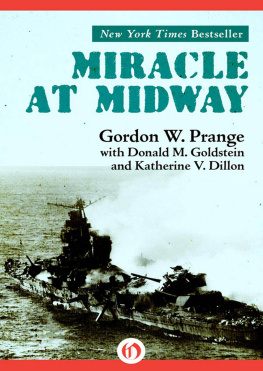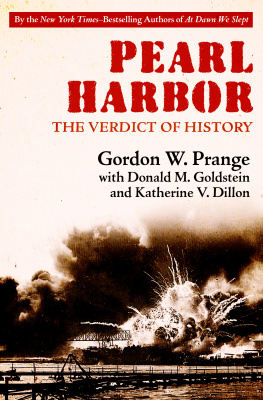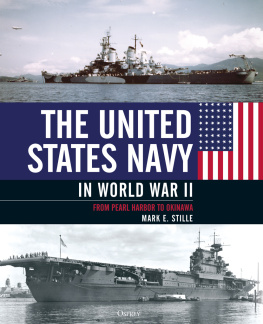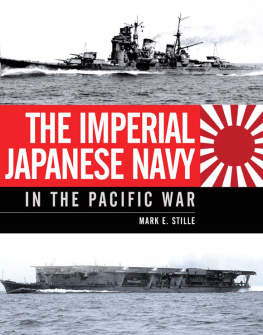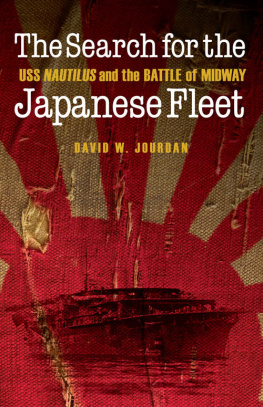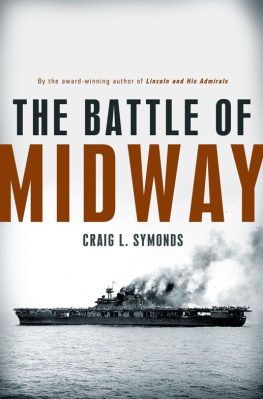Miracle at Midway
Gordon W. Prange with Donald M. Goldstein and Katherine V. Dillon

CONTENTS
INTRODUCTION
When the late Gordon W. Prange, Professor of History at the University of Maryland, passed away in 1980, he left behind several manuscripts in various stages of completion. The first of these, a massive study of the Japanese attack on Pearl Harbor, came to light in a condensed version in November 1981 under the title At Dawn We Slept: The Untold Story of Pearl Harbor.
The current volume is the sequel to At Dawn We Slept. Readers of that book will recognize many of the personalities here. Indeed, Pranges thirty-seven years of research on Pearl Harbor gave him considerable insight into the Midway conflict even before the Readers Digest requested that he submit a manuscript on that subjectpublished in condensed form in November 1972. In particular, several of the Japanese friends whom he interviewed in connection with Pearl Harbor were also veterans of Midway, or had studied the subject. Pranges Japanese interviews are especially valuable, for little Japanese documentation on Midway is available. Whatever war plans, orders, working papers, messages and other documents were aboard Nagumos four carriers were lost forever when those ships went down at Midway.
On the American side, a number of participants, from Admiral Chester W. Nimitz on down, gave him splendid cooperation. American records of the battle are readily available, for units involved submitted detailed reports. Yet one must approach these documents with a skeptical eye and an open mind, remembering that they were written much too close to the event for proper perspective and are understandably tinged with wishful thinking. This is especially true of accounts of air warfare, with its foreshortened vision. If one accepted as gospel all the claimed results at Midway, the Americans sank everything short of the Imperial palace. By the same token, the Japanese press touted the engagement as a resounding victory.
Prange and the two of us have striven for a balanced judgment. Thus, in this volume the Americans and the Japanese receive as near equal time as is possible in view of the material available.
Any work of history is necessarily a joint venture. Space does not permit thanking everyone who contributed to the current work. But we wish to pay special and heartfelt tribute to two individuals. The first is Robert E. Barde, a former U.S. Marine Corps officer who was one of Pranges students at the University of Maryland. Under Pranges direction, Barde wrote a doctoral dissertation on the subject MidwayA Study in Command. Barde very generously turned over to Prange this dissertation as well as the background material upon which it was based. These documents included the records of many interviews which Barde held with survivors of Midway, both in the United States and in Japan. This material has been invaluable in piecing together the current work.
The other individual whom we wish to thank is Masataka Chihaya, formerly an officer of the Imperial Japanese Navy, who for many years was Pranges representative in Japan and a close personal friend. Chihaya conducted a number of interviews on behalf of Prange when the latter was unable to be in Japan to do so for himself; and he collected valuable source material unavailable in the United States.
In view of Pranges drive to bring in all the sheaves meticulously before he began threshing, it is possible that he would not have considered his Midway manuscript ready for publication. But we think otherwise, and we as co-authors have worked diligently to try to meet the standards of our mentor. It is a good story, one in which all Americans can take pride. More than a decade has elapsed since the last book-sized treatment of Midway; we believe that the current generation may be ready for a retelling of what military historians consider among the most decisive battles of history.
This volume complements, rather than supplants, other fine works in this area. Midway: The Battle That Doomed Japan, by Mitsuo Fuchida and Masatake Okumiya, edited by Clarke H. Kawakami and Roger Pineau, remains a prime source from the Japanese side, and the writers are much indebted to it. We also wish to give a special salute to Samuel Eliot Morisons naval history, Coral Sea, Midway and Submarine Actions, and to Walter Lords wonderfully human Incredible Victory. Other worthy and valuable works are cited in the bibliography.
Because the story of Midway is such a complicated one, with several actions going on at once, the authors have tried to make the readers task a little easier by compartmentalizing the chapters dealing with the actual battle. Hence, the attack on Midway is treated separately, as are the attacks by land-based bomber, carrier-based torpedo plane, carrier-based dive bomber, etc. Anyone interested in knowing exactly what went on at a given minute is referred to the timetable in the appendices.
The reader will find herein little or nothing of the interplay of politics with the military which was necessary for an understanding of Midways historical opposite, Pearl Harbor. War was a settled fact; the national course was set. So Midway is the saga of a straightforward naval operation, albeit a very complicated and intricate one, wherein, ironically, surface ships never came in contact with one another.
We would like to bring to the readers attention a few of the idiosyncrasies of the text:
1. In conformity with the documentation and with naval custom, we have used the military twenty-four-hour clock. This has the great virtue of preventing any confusion between A.M. and P.M.
2. Whenever possible, times given are local. Events taking place in Japan are given in Tokyo time; events at and near Midway in Midway time. Tokyo was twenty-one hours ahead of Midway; i.e., an event taking place at 0700 on June 5 Tokyo time happened at 1000 on June 4, Midway time.
3. For the sake of brevity and local color, we have used naval abbreviations of the day in many places throughout the text. Most of these are self-explanatory, but for the readers convenience we have included a glossary of such terms. We have also followed the navy custom of omitting the article the when referring to a warship by name.
4. Along with the glossary, we have included a list of key personnel, the composition of forces, and a timetable of major events.
5. The pictures and charts herein represent a selection among the many available in the Prange files.
6. The bibliography is selective rather than comprehensive.
Readers looking for sensational revelations in this book will not find them. The battle took place; certain results were obtained. What remains of controversy is either in the area of speculationwhat if the Japanese had won?wherein the reader may give imagination free rein, or in the tactical, where the wisdom or folly of a given action is endlessly debatable by those who enjoy such debates. We have reached certain conclusions, with which no doubt some may disagree.
Above all, for the reader we wish a few hours of the interest and pleasure of a good story, and a quickening of pride in Americas heritage.
D ONALD M. G OLDSTEIN , P H .D.
Associate Professor of
Public and International Affairs
University of Pittsburgh
Pittsburgh, Pennsylvania
K ATHERINE V. D ILLON
CWO, USAF (Ret.)
Arlington, Virginia

